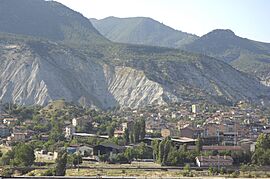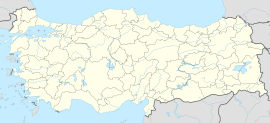Karabük facts for kids
Quick facts for kids
Karabük
|
|
|---|---|
 |
|
| Country | Turkey |
| Province | Karabük |
| District | Karabük |
| Elevation | 301 m (988 ft) |
| Population
(2022)
|
125,403 |
| Time zone | TRT (UTC+3) |
| Postal code |
78000
|
| Area code | 0370 |
| Climate | Cfa |
Karabük is a city located in the Black Sea area of Turkey. It is the main city of both Karabük Province and Karabük District. In 2022, about 125,403 people lived there. The city is built on land about 301 meters (988 feet) above sea level.
Karabük became important in the 1930s because of its iron and steel factories. It is located near the Filyos River, which is formed by two smaller rivers, the Araç and Soğanlı.
Contents
What Does the Name Karabük Mean?
The name Karabük comes from two Turkish words. Kara means "black," and bük means "bush" or "blackberry bush." So, the name Karabük means "blackbush."
Karabük's History
Karabük is located on an old and important trade route. This route connected the coastal city of Amasra with central Anatolia.
The city's history began in the early years of the Turkish Republic. Back then, it was just a small village with 13 houses. It was part of the Öğlebeli village in Safranbolu. There was also a small train station here on the route between Ankara and Zonguldak.
Karabük started to grow when Turkey began to build more industries. One of the first steel factories in the Republic was built here in 1939. After the factory opened, the town grew very quickly. The Öğlebeli village even became a part of Karabük.
Karabük became a municipality (a town with its own local government) in 1941. It then became a district center in 1953 and a provincial center in 1995. This means it became the main city of its own province.
Ancient City of Hadrianapolis
About 30 kilometers (19 miles) from Karabük is an ancient city called Hadrianapolis. This city dates back to the Roman Empire in the 4th century. You can find many old fountains, churches, and Roman baths there.
Karabük's Climate
Karabük has a humid subtropical climate. This means it has hot and humid summers. Its winters are usually chilly and wet.
| Climate data for Karabük (1991–2020, extremes 1965–2020) | |||||||||||||
|---|---|---|---|---|---|---|---|---|---|---|---|---|---|
| Month | Jan | Feb | Mar | Apr | May | Jun | Jul | Aug | Sep | Oct | Nov | Dec | Year |
| Record high °C (°F) | 20.1 (68.2) |
23.5 (74.3) |
29.7 (85.5) |
32.4 (90.3) |
37.0 (98.6) |
37.6 (99.7) |
41.4 (106.5) |
39.6 (103.3) |
40.9 (105.6) |
33.3 (91.9) |
26.9 (80.4) |
19.3 (66.7) |
41.4 (106.5) |
| Mean daily maximum °C (°F) | 7.3 (45.1) |
12.2 (54.0) |
16.3 (61.3) |
21.1 (70.0) |
24.7 (76.5) |
28.6 (83.5) |
31.7 (89.1) |
32.8 (91.0) |
29.2 (84.6) |
22.3 (72.1) |
15.0 (59.0) |
9.0 (48.2) |
20.8 (69.4) |
| Daily mean °C (°F) | 2.3 (36.1) |
5.8 (42.4) |
8.8 (47.8) |
12.2 (54.0) |
16.8 (62.2) |
20.5 (68.9) |
23.3 (73.9) |
23.9 (75.0) |
20.2 (68.4) |
14.6 (58.3) |
8.1 (46.6) |
3.9 (39.0) |
13.4 (56.1) |
| Mean daily minimum °C (°F) | −0.9 (30.4) |
1.5 (34.7) |
3.4 (38.1) |
5.4 (41.7) |
10.8 (51.4) |
14.6 (58.3) |
16.3 (61.3) |
16.7 (62.1) |
13.5 (56.3) |
9.5 (49.1) |
3.6 (38.5) |
0.7 (33.3) |
7.9 (46.2) |
| Record low °C (°F) | −11.5 (11.3) |
−11.8 (10.8) |
−4.8 (23.4) |
−2.1 (28.2) |
0.5 (32.9) |
0.7 (33.3) |
10.4 (50.7) |
10.8 (51.4) |
4.6 (40.3) |
0.8 (33.4) |
−5.4 (22.3) |
−10.9 (12.4) |
−11.8 (10.8) |
| Average precipitation mm (inches) | 44.1 (1.74) |
41.8 (1.65) |
42.9 (1.69) |
38.1 (1.50) |
66.3 (2.61) |
82.0 (3.23) |
22.6 (0.89) |
18.0 (0.71) |
31.4 (1.24) |
50.7 (2.00) |
34.9 (1.37) |
49.3 (1.94) |
522.1 (20.56) |
| Average precipitation days | 14.29 | 12.71 | 13.43 | 11.14 | 15.71 | 15.57 | 5.71 | 5.43 | 7.14 | 10.71 | 10.71 | 13.86 | 136.4 |
| Mean monthly sunshine hours | 58.9 | 93.2 | 139.5 | 216.0 | 198.4 | 225.0 | 291.4 | 282.1 | 222.0 | 164.3 | 126.0 | 77.5 | 2,094.3 |
| Mean daily sunshine hours | 1.9 | 3.3 | 4.5 | 7.2 | 6.4 | 7.5 | 9.4 | 9.1 | 7.4 | 5.3 | 4.2 | 2.5 | 5.7 |
| Source: Turkish State Meteorological Service | |||||||||||||
Karabük's Economy and Industries
Karabük has its own natural resources like dolomite and limestone. Coal and manganese are brought in from Zonguldak, and iron ore comes from Divriği. These resources help Karabük have a strong basic industry.
The city is home to important factories. These include a coking plant (which makes coke from coal), blast furnaces (for making iron), a foundry (for casting metal), and tube works (for making pipes). There are also chemical plants that produce things like sulfuric acid.
One of Turkey's biggest steel producers, called Kardemir (which stands for Karabük Iron and Steel Works), is located right here in Karabük.
Gallery
See also
 In Spanish: Karabük para niños
In Spanish: Karabük para niños












